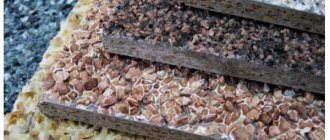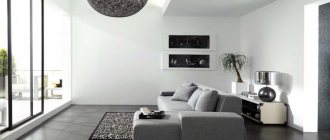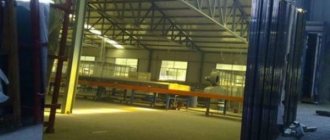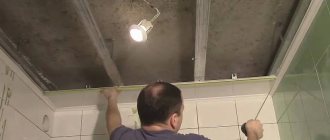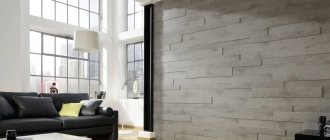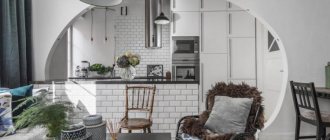The application of reflective film on a polymer base has introduced mirror wallpaper for walls in residential premises of large and small areas into the range of design solutions.
Simplification of the installation technology and the weight of the structure, in contrast to traditional mirrors in frames, allows you to organically include both individual fragments and solid planes with a mirror effect (ceiling, panels, niches) into the interior.
Description
Mirrors in interiors are used not only for their intended purpose, but are also an important tool for visual adjustment of space.
With the right choice and location, it can be used to expand or reduce the room and adjust the layout.
When choosing this finishing option, it is important to choose the right:
- type of panels;
- location;
- room lighting, set it correctly.
Peculiarities
Thanks to mirror panels, you can improve the illumination of the room and reduce the number and intensity of lighting devices. Visually, the room becomes more spacious, brighter , and a feeling of blurred boundaries appears. You can also control the accents in the room, focusing attention on certain details or areas.
Most types of mirror panels provide additional sound insulation. In addition, they also have a direct mirror function. When using mirror panels, it is important not to forget that any contamination will be very noticeable. This is especially true in the kitchen. Therefore, it is worth paying attention to timely cleaning. This can be easily done using regular glass cleaning products.
Where is it recommended to use?
Mirror panels are often used for decoration in:
- shops;
- offices;
- studios;
- fitness clubs;
- night clubs.
In residential areas they are used in:
- bathrooms and shower rooms;
- offices;
- kitchens;
- hallways
Mirror panels can be used for both wall and ceiling decoration . In this case, you need to follow the recommendations for the surface: it must be perfectly flat. The slightest curvature can lead to panels not joining together during installation, image distortion and breakage.
When used in a bathroom or shower room, it is important to pay attention to the resistance of materials to moisture. Many manufacturers have mirror panels designed specifically for rooms with high humidity.
Design techniques
There are many design techniques using mirrors and mirror surfaces.
- Light shades for the walls for decorative finishing and mirror tiles, which are best placed on the wall opposite the window, will help to visually enlarge and expand the room. This way, natural light will be reflected from all surfaces and will create the illusion of more space.
- If the room, on the contrary, is too spacious, then mirror panels will also come to the rescue. In this case, designers advise using tiles from mirrors and frames. Due to this, the reflection will be interrupted, which will visually narrow the space.
- The mirror surface should be placed where it can create the illusion of the presence of a stranger. From this point of view, the best location would be on the wall with a doorway, behind the sofa.
- Some types of tiles can also be used to decorate curved surfaces, such as arched openings.
Features and Benefits
The use of mirror panels in the interior has a number of advantages:
- a great tool for changing visual space;
- suitable for any room;
- combines with various interior styles and other decorative elements;
- high functionality;
- good sound insulation;
- the ability to combine with other materials and create complex structures;
- easy installation and installation;
- wide price range.
The characteristics of mirror panels depend on the type, materials of manufacture, and coating.
What are they?
Mirror panels are available in various designs:
- Image magnification may vary. You can choose a regular mirror that magnifies or reduces.
- Various shapes. Presented:
- mirror tiles;
large panels;
- oval;
- square;
- round;
- rectangular;
- asymmetrical.
- Tinted mirrors.
- Coatings in various shades: pink, gold, silver, gray, etc.
- Waterproof coatings for bathrooms and showers.
Many manufacturers also have the opportunity to order mirror panels according to individual sketches.
There is a huge variety of this finishing element on the market to suit every taste and budget.
Acrylic
Acrylic mirror panels are the most common . They are also called organic glass or plexiglass.
- Acrylic panels are resistant to:
- moisture;
- temperature changes;
- ultraviolet rays.
- They are flexible, so finishing frame structures such as arches or curved corners is often used.
- In addition, they are much lighter than glass and less fragile, so they can be used in larger sizes.
- They are distinguished by good specularity, transmit reflection with high accuracy, without distortion.
But this type has a drawback: they are susceptible to scratches and are not designed for mechanical impact.
Polystyrene
Polystyrene is a synthetic polymer that contains rubber. Due to this, the panels are flexible and can be used for finishing curved surfaces .
This species is highly resistant to temperature changes and exposure to chemicals. Therefore, they are well suited for use, for example, in the kitchen. It is quite resistant to moisture, so it can be used in bathrooms and shower rooms.
The material is susceptible to scratches, so manufacturers often cover such panels with a special protective coating. This helps to avoid the consequences of mechanical impact.
Mirror panels made of polystyrene imitate a mirror well, the image is not distorted and colors are reproduced well. They are produced in various shades, with or without tinting. There are panels with and without self-adhesive backing.
Plastic
Plastic panels are a budget option for finishing and decor , as they are made from inexpensive materials. Therefore, they have gained great popularity. Plastic is also quite flexible, so such mirrors are suitable for finishing complex structures with curves.
They are very easy to process and install. Most options are available on self-adhesive film, so installation does not require additional materials or tools.
These mirror panels are easy to clean and are often covered with a protective film to prevent scratches on the surface. Despite the fact that they are not made from natural ingredients, plastic panels are considered the safest for health and environmentally friendly.
Also, plastic mirror panels have a fairly high resistance to moisture , which makes them suitable for rooms with high humidity. But plastic is very sensitive to temperature changes. This option is also not suitable for use in rooms with low temperatures or for exterior decoration. In addition, such panels distort the image quite strongly, which can be a significant disadvantage.
Materials for production
The performance properties of mirror panels directly depend on the material used in their manufacture.
Acrylic surfaces
Acrylic-based mirror panels for wall decoration are also called organic glass or plexiglass. Such panels are the most common and have the following advantages:
- Impact resistance.
- Increased moisture resistance.
- Heat resistance.
- The material is not afraid of exposure to direct sunlight.
- Specularity is almost 100%.
- It can be colorless, tinted or patterned.
- Can be used on suspended structures, walls and furnishings.
- Has a protective layer to prevent scratches.
Polystyrene coating
Polystrol is a synthetic polymer with rubber. Plates made from this material have the following qualities:
- The products are flexible and therefore can be used for cladding curved surfaces.
- Resistant to chemicals.
- Rubber gives mirror tiles the ability to withstand impacts without compromising their integrity or causing microcracks.
- The material is resistant to high temperatures.
- Polystyrene is not transparent, so a mirror film is applied to the front side of the product.
- The material is easy to care for and is moisture resistant.
Plastic panels
It is quite often used to make mirror slabs. Their popularity is due to the following qualities:
- The material's 100% moisture resistance allows it to be used in the bathroom.
- The film on the front side has a protective coating that can withstand chemical reagents.
- Non-flammable material, although it emits acrid smoke when melted.
- Easy to care for.
- The products are environmentally friendly and hygienic for humans.
- It is impact resistant.
- The material is easy to process - it can be drilled, bent, sawed.
Installation
When installing mirror panels, it is important to follow all instructions and recommendations, be careful and careful. It is important to select the elements correctly and join them so that the image turns out smooth, without distortion. It is important to carefully prepare the surface. It should be perfectly smooth, strong, and dry.
There are several mounting options:
- on a self-adhesive base;
- using staples or brackets;
- on screws;
- on glue.
If you choose a material with a self-adhesive base, then installation will be quite simple. The most important thing is to prepare the surface and select the right structural elements. Then you just need to remove the protective layer and, following the manufacturer’s recommendations, install the panel in the desired place.
In case of using staples or fastenings, the procedure will be as follows:
- First you need to mark the surface. Draw horizontal lines where the top and bottom of the panels will be. Place marks on each of them that correspond to the width of your panels. It is important that they fit snugly against each other, so there should be no gaps between the marks.
- In the upper and lower parts, install the fasteners you have chosen in accordance with the previously drawn lines.
- Use self-tapping screws to secure the fasteners. Be sure to check the strength of the installation. It is recommended to start by installing the lower fasteners, then move on to the upper ones, adjusting them as necessary.
- Treat the panels with a special compound that will provide additional protection.
- Insert the panels into the fasteners.
For installation with screws or self-tapping screws, it is necessary:
- Drill holes in the panels themselves.
- Mark the wall as described in the previous method.
- Next, you need to attach the panel to the surface and make marks through the holes made earlier.
- In the places that have been marked, drill holes and insert snipes.
- Place a special gasket between the mirror surface and the screw.
- Next, the panel is raised so that the screws fit into the drilled holes and are secured.
Installation on glue is carried out using a special substance . It does not harden completely, remains soft in consistency and, if necessary, allows you to easily remove the panel.
The glue is applied to the entire surface of the panel, leaving approximately 6 mm margins along the edges, after which the mirrors must be pressed to the surface. It is best to also mark the wall first to avoid incorrect joints.
Types of installation of mirror panels
Polyurethane wall panels
Installation of panels can be carried out in several ways, depending on the type of product and supporting structure:
- Installation of plastic panels on the frame using clamps, metal brackets or flat head screws. This type of fastener is suitable for long-length products and for finishing the entire wall plane. The lathing can be made of a steel profile or a wooden block, the only condition is that the resulting surface is flat;
- Installing similar parts on a wall without a frame using glue or liquid nails. In this case, the plane must be additionally leveled so that there are no dips or bulges in the finished version. Most often, acrylic panels are attached using this method, since they have a soft base and are not suitable for installation on lathing.
All of the listed methods for installing mirror panels are simple and can therefore be done independently. Thanks to this, such products allow you to save personal funds; moreover, during work, unlike finishing with other materials, a large amount of construction waste is not created, which is also a positive advantage of mirror panels.
What to look for when choosing?
When choosing mirror panels, it is important to pay attention to:
- Type of panels and materials . Choose those that are most suitable for your space and requirements.
- Quality of materials and coating . It is important to check that the coating is of high quality and that the image meets your expectations.
- Additional functions . If, for example, you need a mirror with a magnification factor or a certain shade, also pay attention to this.
- Packaging integrity . Upon delivery, also check the panels themselves for integrity, damage, chips, and cracks.
These are the main factors that require increased attention. Also, do not forget to decide on the type of installation and purchase the necessary additional materials and tools.
Mirror panels are an excellent finishing option and a tool for visually changing space, which will fit perfectly into any interior and become a stunning accent. Choose the ones that suit you based on functionality, style and budget and enjoy a unique interior.
Advantages of mirror panels in the interior
Wooden 3d panels
The main advantage of these products is their cost and ease of installation. Depending on the type of panel, its installation can be carried out using adhesive tape or special mastic. Mirror panels on a self-adhesive base are quite simple to install; just tear off the protective film on the back side and apply it to the desired location. Many manufacturers produce parts that are immediately equipped with this tape, but if there is no such panel, then you can glue any other panel using double-sided tape.
Another advantage is the moisture resistance of the product. Unlike many other finishing materials, plastic wall panels for interior decoration perfectly withstand exposure to moisture, as well as direct ingress of water, so they can be used in a bathroom, toilet or swimming pool.
Mirror panels on the ceiling
Mirror ceiling panels used for wall decoration are easy to maintain and do not require special maintenance conditions; any alcohol-based chemicals can be used to clean them. They also provide additional sound insulation - plastic perfectly absorbs vibrations from sound.
